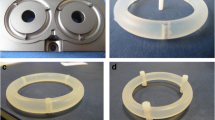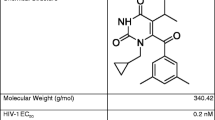Abstract
UC781 is potent, hydrophobic, non-nucleotide reverse transcriptase inhibitor (NNRTI) against the human immunodeficiency virus (HIV). UC781 is currently being investigated for use as a potential HIV microbicide. A study in rhesus macaques demonstrated that a 100-mg UC781-loaded silicone elastomer vaginal ring released limited amounts of UC781 into the vaginal fluid and tissue after 28 days. The reason for this was due to the hydrophobic nature and limited aqueous solubility of UC781. This study describes the manufacture of UC781-loaded polyethylene vinyl acetate (PEVA) vaginal rings, which have an improved in vitro release rate of UC781 when compared to UC781-loaded silicone elastomer vaginal rings. The study demonstrates that the UC781 in the PEVA rings is mostly in its amorphous form due to the rings being manufactured above UC781’s melting point. Furthermore, the rings do not show any signs of UC781 degradation, such as the presence of UC22.




Similar content being viewed by others
References
Woolfson AD, Elliott GRE, Gilligan CA, Passmore CM. Design of an intravaginal ring for the controlled delivery of 17beta-estradiol as its 3-acetate ester. J Control Release. 1999;61:319–28.
Malcolm RK. Vaginal rings for controlled release drug delivery. In: Rathbone MJ, Hadgraft J, Roberts MS, Lane ME, editors. Modified release drug delivery technology. 2nd ed. New York: Informa Healthcare; 2008. p. 499–510.
Brucker C, Karck U, Merkle E. Cycle control, tolerability, efficacy and acceptability of the vaginal contraceptive ring, NuvaRing®: results of clinical experience in Germany. Eur J Contracept Reprod Health Care. 2008;13:31–8.
Woolfson AD, Malcolm RK, Gallagher RJ. Design of a silicone reservoir intravaginal ring for the delivery of oxybutynin. J Control Release. 2003;91:465–76.
Ahrendt HJ, Nisand I, Bastianelli C, Gomez MA, Gemzell-Danielsson K, Urdl W, et al. Efficacy, acceptability and tolerability of the combined contraceptive ring, NuvaRing, compared with an oral contraceptive containing 30 mg of ethinyl estradiol and 3 mg of drospirenone. Contraception. 2006;74:451–7.
Chaplin S, Peers T. NuvaRing: new combined hormonal contraceptive device. Prescriber. 1999;20:17–20.
Woolfson AD, Malcolm RK, Gallagher R. Drug delivery by the intravaginal route. Crit Rev Ther Drug Carrier Syst. 2000;17:509–55.
Henriksson L, Stjernquist M, Boquist L, Cedergren I, Selinus I. A one-year multicenter study of efficacy and safety of a continuous, low-dose, estradiol-releasing vaginal ring (Estring) in postmenopausal women with symptoms and signs of urogenital aging. Am J Obstet Gynecol. 1996;174:85–92.
Woolfson AD, Malcolm RK, Morrow RJ, Toner CF, McCullagh SD. Intravaginal ring delivery of the reverse transcriptase inhibitor TMC 120 as an HIV microbicide. Int J Pharm. 2006;325:82–9.
Malcolm RK, Woolfson AD, Morrow RJ, Toner CF, McCullagh SD. Long-term, controlled release of the HIV microbicide TMC120 from silicone elastomer vaginal rings. J Antimicrob Chemother. 2005;56:954–6.
Balzarini J, De Clercq E. The thiocarboxanilides UC-10 and UC-781 have an additive inhibitory effect against human immunodeficiency virus type 1 reverse transcriptase and replication in cell culture when combined with other antiretroviral drugs. Antivir Chem Chemother. 1997;8:197–204.
Buckheit Jr RW, Hollingshead M, Stinson S, Fliakas-Boltz V, Pallansch LA, Roberson J, et al. Efficacy, pharmacokinetics, and in vivo antiviral activity of UC781, a highly potent, orally bioavailable nonnucleoside reverse transcriptase inhibitor of HIV type 1. AIDS Res Hum Retrovir. 1997;13:789–96.
Borkow G, Barnard J, Nguyen TM, Belmonte A, Wainberg MA, Parniak MA. Chemical barriers to human immunodeficiency virus type 1 (HIV-1) infection: retrovirucidal activity of UC781, a thiocarboxanilide nonnucleoside inhibitor of HIV-1 reverse transcriptase. J Virol. 1997;71:3023–30.
Zussman A, Lara L, Lara HH, Bentwich Z, Borkow G. Blocking of cell-free and cell-associated HIV-1 transmission through human cervix organ culture with UC781. AIDS. 2003;17:653–61.
Parniak MA. Nonnucleoside reverse transcriptase inhibitors as anti-HIV-1 microbicides. AIDS. 2001;15:S56.
Balzarini J, Naesens L, Verbeken E, Laga M, Van Damme L, Parniak M, et al. Preclinical studies on thiocarboxanilide UC-781 as a virucidal agent. AIDS. 1998;12:1129–38.
Patton DL, Cosgrove Sweeney YT, Balkus JE, Rohan LC, Moncla BJ, Parniak MA, et al. Preclinical safety assessments of UC781 anti-human immunodeficiency virus topical microbicide formulations. Antimicrob Agents Chemother. 2007;51:1608–15.
Schwartz JL, Kovalevsky G, Lai JJ, Ballagh SA, McCormick T, Douville K, et al. A randomized six-day safety study of an antiretroviral microbicide candidate UC781, a non-nucleoside reverse transcriptase inhibitor. Sex Transm Dis. 2008;35:414–9.
Hardy E, Hebling EM, Sousa MH, Almeida AF, Amaral E. Delivery of microbicides to the vagina: difficulties reported with the use of three devices, adherence to use and preferences. Contraception. 2007;76:126–31.
Zhang F, McGinity JW. Properties of sustained-release tablets prepared by hot-melt extrusion. Pharm Dev Technol. 1999;4:241–50.
Leuner C, Dressman J. Improving drug solubility for oral delivery using solid dispersions. Eur J Pharm Biopharm. 2000;50:47–60.
Rambali B, Verreck G, Baert L, Massart DL. Itraconazole formulation studies of the melt-extrusion process with mixture design. Drug Dev Ind Pharm. 2003;29:641–52.
Hülsmann S, Backensfeld T, Keitel S, Bodmeier R. Melt extrusion—an alternative method for enhancing the dissolution rate of 17β-estradiol hemihydrates. Eur J Pharm Biopharm. 2000;49:237–42.
Hancock BC, Zografi G. Characteristics and significance of the amorphous state in pharmaceutical systems. J Pharm Sci. 1997;86:1–12.
Loxley A, Mitchnick M, Okoh O, McConnell J, Goldman L, Morgan C, et al. Ethylene vinyl acetate intravaginal rings for the simultaneous delivery of the antiretroviral UC781 and contraceptive levonorgestrel. Drug Deliv Transl Res. 2011;1:247–55.
Author information
Authors and Affiliations
Corresponding author
Rights and permissions
About this article
Cite this article
McConville, C., Major, I., Friend, D.R. et al. Development of a UC781 releasing polyethylene vinyl acetate vaginal ring. Drug Deliv. and Transl. Res. 2, 489–497 (2012). https://doi.org/10.1007/s13346-012-0101-3
Published:
Issue Date:
DOI: https://doi.org/10.1007/s13346-012-0101-3




